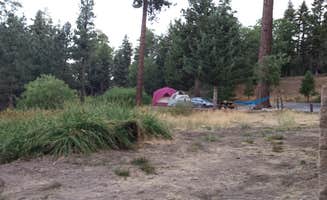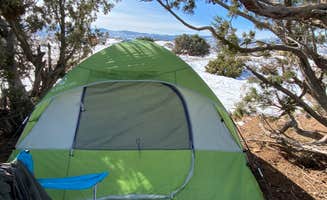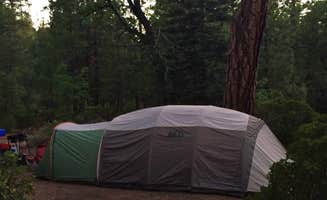The San Bernardino Mountains surrounding Loma Linda, California offer tent campsites at elevations ranging from 2,000 to 9,000 feet. This dramatic elevation change creates temperature differences of 15-25°F between the valley floor and mountain camping areas. Fire restrictions are common during summer and fall months, with most mountain campgrounds implementing bans from June through October.
What to do
Fishing access: Yucaipa Regional Park maintains three stocked lakes where campers can fish throughout the year. "Three lakes for fishing, water park during the summer, and friendly helpful staff," notes Bryan H. The park offers both shoreline fishing and designated casting areas.
Mountain biking trails: Riders staying at Keller Peak Yellow Post Campsites can access multiple mountain biking routes directly from their campsites. "The bike trail is fun and a challenge," reports Sam H. The Exploration Trail winds around the campsites up to the peak, offering varied terrain for different skill levels.
Fire lookout visit: Hike to the Keller Peak Fire Lookout tower for 360-degree mountain views. "The Keller Peak Lookout was amazing. I thought it was just a tourist attraction but it's really a staffed (with volunteers) active fire lookout," shares Steve H. The volunteer staff often provides information about local wildlife and forest management.
What campers like
Temperature relief: Mountain tent sites provide significant cooling during summer months. "Weather is definitely colder than in the valley, got snow overnight in mid May," reports Jillian about Deep Creek Hot Springs Campground. The 20-30°F temperature difference makes camping comfortable even during summer heat waves.
Camp layout variety: "The sites were interestingly laid out and some had little wooded areas that you actually camp behind, others had interesting ground layouts with multiple levels, we found it really cool," shares Aleena S. about Lake Arrowhead - Green Valley Lake Recreation Area. Many sites feature natural rock formations that create natural room dividers.
Night sky viewing: The higher elevation campsites provide exceptional stargazing opportunities. Chelsea R. notes about Thomas Hunting Grounds Yellow Post Sites: "Listen to great horned owls while taking in the views!" Light pollution is minimal at most mountain sites, allowing clear views of the Milky Way during new moon phases.
What you should know
Road conditions: Access to many dispersed camping areas requires appropriate vehicles. "The road to the trailhead is very bumpy (you definitely need a 4x4 with good clearance)," warns Daryna L. about accessing Fishermans Group Campground. Forest service roads may deteriorate following winter storms or heavy rains.
Fire restrictions: Many campgrounds limit or prohibit open flames during summer and fall. David V. points out for Thomas Hunting Grounds: "They are very strict on parties are not allowed. NO FIRES." Check with the local ranger station for current restrictions, which change based on conditions.
Water availability: Most dispersed sites lack running water. "The dispersed tent sites at Mill Creek require self-sufficiency, as they lack facilities entirely," requires campers to bring 1-2 gallons per person per day. Streams may not be reliable water sources during late summer months.
Tips for camping with families
Water recreation options: Mill Creek Dispersed Camping provides stream access during spring months. Yucaipa Regional Park offers more developed water activities, with one reviewer mentioning "a fun splash zone" that's ideal for children during hot summer days.
Easier access sites: "The camp sites are good. You are within a mile from the lake and little town there," notes Stephen S. about Green Valley Lake Recreation Area. The proximity to small towns provides backup options if camping conditions become challenging.
Wildlife viewing opportunities: Many campers report frequent wildlife sightings in the San Bernardino Mountains. David O. described seeing "deer, rabbits and a multitude of squirrels" at Manker Campground. Morning and evening hours typically offer the best wildlife viewing times.
Tips from RVers
Limited dispersed options: Most free camping areas have restrictions for RVs. Francisco F. warns about Mill Creek Dispersed Camping: "The road up to the actual spot is gravel, with lots of potholes and washboard areas, which would make it difficult for an RV...There is no way that even a Class C rig would be able to take that steep incline and immediately do that sharp turn."
Hookup availability: Paul C. recommends Yucaipa Regional Park for its "large concrete pads that can handle any rig." The park provides full hookups with water, electric and sewer connections, along with a sanitary dump station for departing campers.
Temperature management: Higher elevation campsites often experience cold nights even in summer. Anneliese S. notes about Yucaipa Regional Park: "Some sites have better shade than others. I'm here in the heat but my AC is keeping up." Overnight temperatures can drop below 40°F even in summer months at sites above 7,000 feet.













